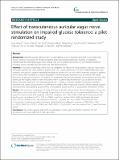| dc.identifier.citation | Huang, F., J. Dong, J. Kong, H. Wang, H. Meng, R. B. Spaeth, S. Camhi, et al. 2014. “Effect of transcutaneous auricular vagus nerve stimulation on impaired glucose tolerance: a pilot randomized study.” BMC Complementary and Alternative Medicine 14 (1): 203. doi:10.1186/1472-6882-14-203. http://dx.doi.org/10.1186/1472-6882-14-203. | en |
| dc.description.abstract | Background: Impaired glucose tolerance (IGT) is a pre-diabetic state of hyperglycemia that is associated with insulin resistance, increased risk of type II diabetes, and cardiovascular pathology. Recently, investigators hypothesized that decreased vagus nerve activity may be the underlying mechanism of metabolic syndrome including obesity, elevated glucose levels, and high blood pressure. Methods: In this pilot randomized clinical trial, we compared the efficacy of transcutaneous auricular vagus nerve stimulation (taVNS) and sham taVNS on patients with IGT. 72 participants with IGT were single-blinded and were randomly allocated by computer-generated envelope to either taVNS or sham taVNS treatment groups. In addition, 30 IGT adults were recruited as a control population and not assigned treatment so as to monitor the natural fluctuation of glucose tolerance in IGT patients. All treatments were self-administered by the patients at home after training at the hospital. Patients were instructed to fill in a patient diary booklet each day to describe any side effects after each treatment. The treatment period was 12 weeks in duration. Baseline comparison between treatment and control group showed no difference in weight, BMI, or measures of systolic blood pressure, diastolic blood pressure, fasting plasma glucose (FPG), 2-hour plasma glucose (2hPG), or glycosylated hemoglobin (HbAlc). Results: 100 participants completed the study and were included in data analysis. Two female patients (one in the taVNS group, one in the sham taVNS group) dropped out of the study due to stimulation-evoked dizziness. The symptoms were relieved after stopping treatment. Compared with sham taVNS, taVNS significantly reduced the two-hour glucose tolerance (F(2) = 5.79, p = 0.004). In addition, we found that taVNS significantly decreased (F(1) = 4.21, p = 0.044) systolic blood pressure over time compared with sham taVNS. Compared with the no-treatment control group, patients receiving taVNS significantly differed in measures of FPG (F(2) = 10.62, p < 0.001), 2hPG F(2) = 25.18, p < 0.001) and HbAlc (F(1) = 12.79, p = 0.001) over the course of the 12 week treatment period. Conclusions: Our study suggests that taVNS is a promising, simple, and cost-effective treatment for IGT/ pre-diabetes with only slight risk of mild side-effects. | en |


